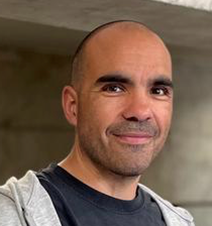Design of AW Filters based on Synthesis Methodologies and Physical Implementation
Speaker: Jordi Verdu
WavesLab – Telecommunications and Systems Engineering Departament
Universitat Autònoma de Barcelona – UAB, Spain
Abstract
As the radio frequency (RF) spectrum grows increasingly congested, the design of filtering modules for end-user terminals has become a challenging and critical task. The difficulty stems from the need to meet stringent transmission specifications—such as sharp selectivity, low insertion loss, and strong out-of-band rejection—while working within the constraints of acoustic wave (AW) technology, which is widely used due to its compactness and high performance. The expansion of 5G networks, with newly allocated frequency bands extending into higher ranges, has further intensified the demand for filters capable of handling broader bandwidths and higher frequencies. These requirements push traditional filter design approaches to their limits and call for more advanced, flexible methodologies.
Ladder-type filters based on acoustic wave resonators have long been the standard in RF filter design, particularly for sub-6 GHz applications. Their simplicity and reliability make them suitable for many commercial use cases. However, their inherent structural rigidity limits the diversity of filtering functions they can support. This becomes a significant drawback as modern wireless systems demand more complex responses, such as multi-band operation or ultra-wideband performance.
During the first part of the course, the synthesis of acoustic wave filters will be presented. These methods enable the analytical design of more sophisticated filter topologies that may go beyond the conventional ladder configuration. A critical aspect of this advancement is the deeper understanding and utilization of the input phase response. By controlling the input phase, designers can balance performance and manufacturability. These new synthesis techniques allow the creation of advanced filter structures capable of addressing multi-band requirements and sharper frequency transitions, all while respecting the physical and technological constraints of AW technologies. They not only provide improved performance but also maintain feasibility for large-scale production.
The second part of the course will be focused on the transition from the reactance Butterworth Van Dyke model to a more realistic physical description of the resonators composing the filter. Different considerations must be considered, not only from the geometry limitations, but also the effect of unwanted spurious modes. The Coupling-of-modes, leveraged on 2D/3D Multiphysics modelling, allows to relate the ideal reactance with the real physical description.
About the speaker

Prof. Jordi Verdú (M'18-SM20) received M.S. degree in Telecommunication Engineering in 2006 and a Ph.D. degree (Cum Laude) in 2010 from the Universitat Autònoma de Barcelona (UAB) awarded with the department best thesis prize. From 2006 to 2010 he was a member of the Antenna and Microwave Systems (AMS). In 2010 he joined the RF System Group at the European Spallation Source in Bilbao (ESS-B) as a group coordinator. In 2011-2012 he was at the École Polytechnique Fédérale de Lausanne through a Marie Curie grant. In 2013 he joined the Theory Signal Communication group at Universitat Politècnica de Catalunya.
Currently, he is an Associate Professor at the Universitat Autònoma de Barcelona where he teaches microwave engineering courses, and member of the WavesLab Group. He is the Vice-Chair of IEEE Technical Committee MTT-6 RF MEMS and Microwave Acoustics Committee, reviewer for IEEE Transactions on Microwave Theory and Techniques, IEEE Microwave and Wireless Components Letters. He serves as a member of the Technical Review Board for the European Microwave Conference.
He has been extensively working on linear modelling of acoustic wave devices, and new synthesis techniques and advanced configurations for acoustic wave filters. His current research interest includes the design of microwave devices and linear modelling, but also the design of active devices for Space applications.
